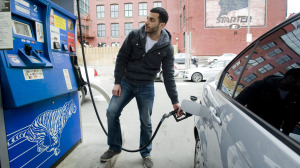Speculators fuel high gasoline prices, analysts say
 Gasoline prices in Canada are climbing to near-record highs, and financial speculators betting on the closing of a Philadelphia refinery are partly to blame.
Gasoline prices in Canada are climbing to near-record highs, and financial speculators betting on the closing of a Philadelphia refinery are partly to blame.Pump prices shot up in several major cities Wednesday – topping $1.40 a litre at many Toronto gas stations – as motorists across the country feel the pinch of steadily rising prices in recent weeks, even as crude oil costs have remained relatively stable.
Gas prices typically rise in the spring as refiners shut some operations and reduce supply in order to switch from producing winter grades to less-polluting summer blends.
But this year, the refining market in eastern North America is even tighter as several refineries have been closed amid competitive pressures. And speculators are plowing money into gasoline futures on the New York Mercantile Exchange in anticipation of further closings, notably a large Sunoco (SUN-N39.350.320.82%) refinery in Philadelphia. The company is looking for a buyer for the facility, which has been squeezed by high crude prices, slack demand in the eastern U.S., and growing competition from mega-refineries in India and China.
As a result, consumers are paying more for their fuel.
“The Sunoco situation is significant and the market has priced in a closure of that facility by July,” said Jim Ritterbusch, who heads oil trading advisory firm Ritterbusch & Associates based near Chicago. “This is a real sweet spot in terms of speculative interest in the gasoline market.”
Mr. Ritterbusch said there is a near-record number of speculative contracts on the exchange as traders ride the typical spring price increase and anticipate a further rise, resulting either from higher crude costs or further reductions in refining capacity.
The average Canadian price for regular gas jumped from $1.20 per litre in January to $1.35 as of Tuesday this week, before it ticked up further on Wednesday. The increase at the pump has continued even as crude prices have been relatively stable since mid-February.
Canadian pump prices could climb to a new record this summer, some analysts have predicted, assuming the U.S. economy continues to rebound and international crude producers see more political upheaval.
Higher prices are already having an economic impact, driving up transportation costs for businesses and taking disposable income out of the pockets of consumers. Should prices spike to $1.70 a litre, the economic fallout will be more noticeable, BMO Nesbitt Burns economist Sal Guatieri said in a report Wednesday.
“Although the recent increase in gasoline prices hasn’t changed our outlook for growth, a further runup surely would,” Mr. Guatieri said. Another 30-per-cent increase – precipitated, perhaps, by an escalation of tension in the Middle East – would knock a full percentage point off the bank’s lacklustre forecast for growth, and drive up unemployment.
Canadian pump prices are heavily influenced by U.S. petroleum markets. The Nymex sets prices for gasoline imports at New York harbour, a key source of supply for the U.S. wholesale market, which directly influences Canadian prices. And on the Nymex, the bulls are on a run.
But Mr. Ritterbusch doesn’t subscribe to the view that gasoline prices are inexorably headed above $5 (U.S) a gallon – or $1.70 a litre in Canada. Unless there is a flare-up in the Middle East, he argues that both crude and gasoline markets are primed for declines because U.S. demand is flat and supplies remain relatively plentiful.
He said it is unlikely Sunoco will close the Philadelphia facility, at least until the end of the summer when seasonal demand typically falls off. Two other area refineries – one owned by Sunoco and the other by ConocoPhillips – have already been shuttered.
In a recent report, the U.S. Energy Information Administration warned that the closing of the three East Coast refineries could cause price spikes and higher prices over the long term in a market area that reaches into western Pennsylvania and New York, notably Buffalo.
The Canadian gasoline market is really a series of regional markets, more closely tied to neighbouring U.S. regions than to east-west linkages. The large Irving Oil refinery in Saint John supplies New England as well as Atlantic Canada. The Southern Ontario market is closely linked to the Great Lakes region, and wholesale prices in Toronto and Buffalo move in virtual tandem.
The upheaval in the refining sector is exacerbating other factors that have sent pump prices sharply higher in much of the country, far from the U.S. East Coast.
The Prairies have been somewhat less affected because refiners there process Western Canadian crude, which is being steeply discounted in price due to lack of pipeline capacity to move it to new markets. Even after taxes are removed, prices in Edmonton and Calgary are nearly 10 cents a litre less than those in Vancouver and Toronto.
But a spring runup at the pumps has become as predictable as the first robin.
“Usually, we get a runup in wholesale prices as we get closer to the summer driving season – there is a boost in demand and refiners are building up inventories to get ready for it,” said Jason Parent, senior associate at the Kent Group, which advises on Canadian petroleum markets.
You can return to the main Market News page, or press the Back button on your browser.

